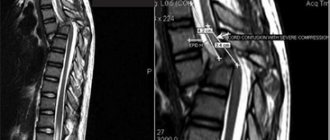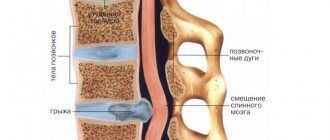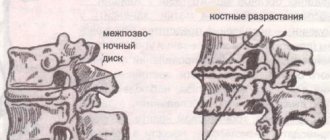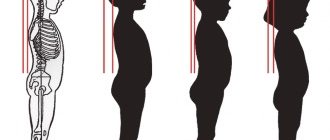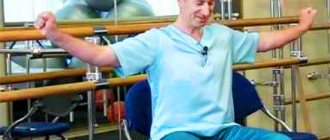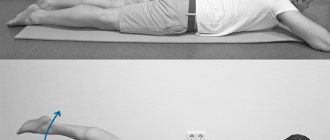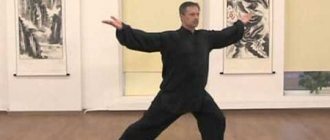From this article you will learn:
- The need for exercise therapy for osteochondrosis of the cervical spine
- Rules for exercise therapy for cervical osteochondrosis
- Exercise therapy for cervical osteochondrosis at home
- Exercise therapy for osteochondrosis of the cervical spine according to Butrimov’s method
- Exercise therapy for osteochondrosis of the cervical spine according to Bubnovsky’s method
Exercise therapy for cervical osteochondrosis is one of the most effective ways to treat it. Thanks to regular training, you can strengthen muscles and improve blood circulation in the area of affected intervertebral discs and vertebrae.
Any neurologist will recommend that you perform exercises to prevent osteochondrosis. We have collected the most popular ones in this article and described in detail the steps to implement them. If you exercise regularly, the cervical vertebrae will bother you less.
The need for exercise therapy for osteochondrosis of the cervical spine
Cervical osteochondrosis is called degenerative-dystrophic lesion of the spine. The cause of the development of pathology is the inability of cartilage tissue to retain moisture. Due to their gradual destruction, the vertebrae become deformed, and bone growths appear on them - osteophytes. Displacement of pathological formations leads to damage to soft tissues, compression of blood vessels and spinal roots. That is why with cervical osteochondrosis, pain occurs in the neck, back of the head, shoulders, swelling appears, movements become constrained, the patient’s blood pressure often fluctuates, dizziness, vision and hearing deteriorate.
Most often, osteochondrosis occurs due to:
- sedentary lifestyle;
- excessive loads on the vertebrae and intervertebral discs;
- untimely treatment of acute diseases;
- neglect of chronic diseases.
Most of those who are at risk for the listed points sooner or later develop osteochondrosis.
Is it possible to avoid it? Yes, if you exclude factors that lead to premature destruction of disks. As a preventative measure, the following are recommended:
- massage course 2-3 times a year;
- quitting smoking and drinking alcohol;
- frequent walks in the fresh air.
Exercise therapy is considered the best way to maintain health with osteochondrosis of the cervical spine. A set of therapeutic exercises also has a good effect on overall well-being.
What moves our neck
If you think broadly, muscles are divided into two categories - those that move bones in relation to each other; and those that move our body or its parts in space. What muscle category is everyone trying to strengthen/pump? See, the weight of the skull (the load on the cervical spine) is relatively small. We don’t wear anything on our heads, we don’t rearrange objects with our necks, we don’t lift bags. The relatively large muscles of the neck are either muscles that provide movement of the skull; or the trapezius muscle, which provides movement of the skull and upper limb. Their strengthening will not particularly affect the preservation of statics and congruence of the joints. And keeping your neck healthy won’t help. By the way, pumping up these muscles is quite difficult and the process itself is traumatic. If there is no genetic predisposition, then most likely they will be of normal size. Like many Mr. Olympias, for example.
Rules for exercise therapy for cervical osteochondrosis
One of the main conditions for the effectiveness of classes is fresh air in the room. But in no case should you train in a draft, so as not to add inflammation of the neck muscles to osteochondrosis - it is accompanied by severe pain.
There are certain rules that you need to know about when starting a physical therapy complex:
- clothing for physical therapy should not restrict movement; it is better if it is made of breathable materials and has a loose fit;
- You should not train if you are feeling unwell, have high blood pressure, or have a rapid pulse;
- the course can be divided, rather than completed entirely at once: for example, do a set of isometric exercises in the morning, and do dynamic exercises in the evening;
- In order for physical therapy to have a greater effect, it is important to maintain regularity of exercises - perform them up to 3 times a day;
- Feeling unwell or pain during exercise is a signal to stop training; only after a long rest can you start exercising again.
Massage and physiotherapy in combination with exercise therapy for osteochondrosis of the cervical spine will enhance the therapeutic and preventive effects.
According to rehabilitation specialists and physical therapy doctors, during the training process it is important to focus on your feelings: movements that bring pleasure due to the fact that certain muscle groups work can be done in double volume. But if some exercise causes severe pain in the neck or is accompanied by noise in the head, difficulty breathing, or a feeling of lack of air, it is better not to do it at all.
The frequency of classes and specific exercises that should be included in the complex are determined by the physical therapy doctor after he analyzes the general health of the patient. Contraindications to gymnastics are severe hypertension, glaucoma and severe myopia. It is also impossible to perform complex exercise therapy for heart rhythm disturbances, aortic aneurysm, or recent myocardial infarction. Flu, acute respiratory viral infections, and severe spinal injuries are also reasons for prohibiting training.
Let's set priorities
It’s unlikely that many people do such gymnastics on purpose. People turn their heads and stretch. They often unconsciously tilt their heads to the sides when they sit in one place for a long time. These are reflex actions aimed at warming up the neck.
If we know which exercises will best help stretch and strengthen the cervical spine, it will be easier for us to understand what exactly to do in such moments. And we will not unconsciously turn our heads.
As we have said more than once, it is important to know why we do things. The cervical gymnastics complex is very important, which is obvious:
- When the weakness of the neck muscles is pronounced, the spine experiences extra stress under the weight of the head. This leads to cervical osteochondrosis, pinched nerves, that is, pain and stiffness in movements. If the muscles are weak, they must be strengthened from an early age. This is pain prevention.
- When you work for a long time (most people do this today, the 21st century is the century of sitting or lying down), the muscles become stiff and impede the flow of blood to the head and back to the body. Fresh blood, saturated with oxygen, enters the brain in insufficient quantities - you experience a headache, dizziness, darkening of the eyes, a powerful feeling of fatigue and a great desire to gape. It is precisely at such moments that you need to get up and stretch. And if it’s not possible, at least do a series of neck exercises. This is the prevention of strokes.
- Over the years, the mobility of the joints of the body becomes less. This can be avoided if you regularly do a therapeutic complex so that the joints do not forget about their mobility. Here's another important reason to stretch your neck.
- If you have a pinched neck or osteochondrosis, neck exercises will save you from pain and help you forget about dizziness and ringing in the ears. This is already a treatment.
Now let's look at what exercises gymnastics for the neck consists of. The main load that the cervical spine will experience is static. The main exercises for the cervical spine consist of 10 elements. The video shows the complex itself, and then you will find a detailed text description of all the exercises.
https://www.youtube.com/watch?v=osLKue0RDxo
Exercise therapy for cervical osteochondrosis at home
By performing a set of exercises at home, you can not only get rid of existing pain in the neck and back, but also prevent its occurrence. However, you should not start training without first consulting with a physical therapy doctor or trainer. Only the correct exercise technique and regularity of loads will ensure positive dynamics.
At the beginning of each complex, a warm-up is required. It may consist of several turns of the torso, squats, development of the ankle and knee joints.
Recommended articles on the topic:
- How to massage the abdomen for weight loss: different techniques for health and beauty
- Stone massage: description, benefits, methods
- MRI of three parts of the spine: when is it necessary and what are the features of the procedure
For exercise, it is advisable to choose comfortable clothes made from natural materials that are pleasant to the touch, which will allow you to freely do exercises with a large range of motion.
Simple turns and tilts
Despite its simplicity, bending and turning in the exercise therapy complex for osteochondrosis of the cervical spine are considered the most effective exercises that help:
- get rid of pain;
- remove the load from the cervical vertebrae;
- make the spine more mobile.
It is recommended to perform turns first and then gradually move on to bends. Each type of exercise is repeated 10 times.
Axial rotation
The axial rotation exercise is a good help in stretching muscles. Regular exercise makes the body more flexible and improves blood circulation. You can’t think of a better warm-up for those who have a sedentary job: 2-3 approaches with axial rotation during the day are a fairly effective prevention of osteochondrosis.
Falling tower
This exercise requires caution. It is performed standing, legs apart, shoulders lowered and relaxed as much as possible, chin raised. As you count down to 5–8, you need to slowly move your body and shoulders (without straining them) back, trying to keep the position of your head unchanged. Returning to the starting position should occur very smoothly. "The Leaning Tower" is repeated 8 times.
Strength stretching
The purpose of this exercise is to properly stretch the muscles and make them more elastic. Another effect is a reduction in compression when nerves are pinched. It is not advisable to do this stretching alone - it is better if a trainer monitors the process, because any incorrect action can lead to displacement of the cervical vertebrae and tissue injury.
How to do it:
- tilt your head to the right, trying to reach your earlobe to your right shoulder;
- fix the body in this position for 5–10 seconds;
- put your left hand on your head and make springing movements;
- We do the same stretching in the other direction.
The muscles must be well warmed up before performing this exercise, otherwise, instead of the desired effect, you may get injured ligaments and tendons.
We recommend
Anti-wrinkle facial massage: 10 effective techniques Read more
Stretching with a towel
Stretching with a towel is similar in technique to stretching with force and also allows you to make the muscles that support the cervical vertebrae more elastic. A towel (preferably terry), folded several times, serves as a load amplifier.
How to do it:
- twist the towel into a rope and clasp it with both hands, spaced 30–35 cm apart;
- We bring the towel behind our head and place it on the back of the head;
- pull the towel up so that there is no resistance from the neck muscles - this can be achieved by slightly tilting your head back;
- repeat the exercise 8–10 times.
Proper stretching with a towel helps eliminate muscle spasms and pain.
How to make your neck beautiful and graceful
First, a spiral of six rings is put on the neck, and then annually their number is increased by one.
When discussing ways to help stretch and somewhat narrow the neck, one cannot help but recall the custom of the Burmese Padaung tribe. From about the age of five, every girl begins to wear a copper extension ring, to which more and more hoops are added over time. In such an unusual way, local ladies fight for beauty, which their people have since ancient times placed in direct dependence on the length of the neck.
Of course, this method of fighting for extra millimeters is more than radical and, frankly speaking, not very rational. After all, the rings do not stretch the vertebrae; simply because of their presence, the shoulders gradually lower.
Of course, modern women are not ready to wear such jewelry for years, even for the sake of a colossal improvement in appearance. They act much more wisely - they undertake to regularly perform exercises to stretch the neck muscles and shoulder relaxation. With a responsible approach, the result does not take long to arrive. A pleasant bonus to the “swan” effect is an increase in brain activity due to improved blood flow.
Also read: Sculptural facial massage: how to sculpt yourself without wrinkles.
Exercise therapy for osteochondrosis of the cervical spine according to Butrimov’s method
A feature of exercise therapy according to the Butrimov system for osteochondrosis is the absence of monotonous movements.
All exercises of the complex can be considered the art of maintaining tone and training the muscles located in the cervical spine:
- Pull your chin forward as far as possible and pull it back into your neck. You need to perform movements that stretch the muscles very carefully and slowly, the effect should be achieved without pain.
- Alternate turns of the head to the right and left. Each movement is accompanied by stretching of the neck towards the shoulder joint.
- Turn the head alternately left and right with the chin stretched towards the shoulders.
- Lowering the head down: try to press the chin to the chest, stretching the cervicothoracic region, pull the top of the head up slightly. Smooth return to the starting position with the head pulled back, the chin raised up.
- Turn your head back (in different directions) with maximum amplitude - you need to try to look behind your back and see the whole picture from behind.
- Tilt the head down and smoothly turn the head from this position alternately to the left and right sides. The movements are accompanied by stretching the crown of the head upward at an angle of approximately 45°. The gaze should also be directed upward.
- Tilt the head alternately to the right and left towards the shoulder joint while simultaneously stretching the crown.
- Retracting the head into the neck with circular rotations from this position to the shoulders: after reaching one shoulder, the head is retracted again and is directed in a circular path to the other. Shoulders should be relaxed and straight.
- Slight tilts to the left and right with the gaze directed downwards.
It is permissible to combine several exercises according to the Butrimov system into one. It is assumed that exercise therapy for osteochondrosis of the cervical and thoracic spine should be given at least 12–15 minutes. If you do this type of gymnastics regularly, you will notice the effect within 4-5 months. There are many factors that determine how quickly positive dynamics will appear: the individual characteristics of the body, the patient’s lifestyle, the specific manifestations of osteochondrosis, additional therapy, the correct selection of exercises and the accuracy of their implementation.
The right workouts for a swan neck
Since the time of the beautiful Queen Nefertiti, the “swan” neck has been an undeniable sign of beauty and the pride of a woman.
Home workouts that allow you to make your neck thinner and longer require compliance with 3 important rules:
- Mandatory warm-up - each session is preceded by a short warm-up of the muscles. First you need to do ten slow tilts of your head back and forth and left and right. Then lightly stretch your neck with your fingers from the back and sides (with upward movements). The same slopes complete the preparatory stage.
- Smoothness of action - exercises do not tolerate haste, fussiness and abruptness; they must be performed extremely carefully and slowly. This area of the body can easily be injured by the slightest careless tilt or turn of the head. Therefore, you should not lose concentration and overexert your muscles.
- Moderation of loads - you shouldn’t chase the number of approaches, it’s better to do less, but with better quality. On average, 15 repetitions are enough to start. Then, every week it is recommended to add 5 more. Maximum - 25 repetitions at a time. Exceeding this level, no matter how much you would like to bring a positive result closer, is extremely undesirable.
By the way, it wouldn’t hurt to consult a doctor before starting training - some manipulations can increase intracranial pressure.
Exercise therapy for osteochondrosis of the cervical spine according to Bubnovsky’s method
The exercises developed by Sergei Bubnovsky are aimed at alleviating the condition of osteochondrosis of the cervical spine. Exercise therapy using this method can be done at home. The complex is used not only for treatment, but also for the prevention of spinal diseases.
- "Spring." Choose a comfortable starting position and begin to slowly tilt your head. Gradually we move to a smooth stretching of the neck upward. We repeat the exercise 5 times.
- "Metronome". We sit on a chair and straighten our back. Tilt your head to the left and stay in this position for 30 seconds. We make the same tilt to the right and fix the pose for half a minute.
- "Review". We bend our head slightly and from this position we turn it 5 times to the right and to the left.
- "Goose". We sit up straight, straighten our shoulders. While inhaling, we stretch our chin forward as much as possible, and after three seconds we press it to our shoulder. We fix our head in this position for 12 seconds and smoothly return to the starting position. We repeat the same in the opposite direction. We do 5 repetitions to the right and left. This exercise helps get rid of a double chin and promotes better blood circulation.
- "Heron". Straighten your back as much as possible, place your hands on your knees. Slowly move them behind your back, lifting your chin up. This exercise forces the muscles located in the cervical and thoracic spine to work.
- "Complicated review." Place your left hand on your right shoulder, turning your head to the left. We fix the position for half a minute. We repeat the same actions with the other hand and turns in the opposite direction.
- "Fakir". We raise our hands up, this is the starting position. We connect them and make smooth turns with our heads in different directions. We try to fixate in each position for 2 seconds.
As doctors note, at the initial stage of development of cervical osteochondrosis, it is almost impossible to notice it; it does not cause any unpleasant or painful sensations. At this stage, the disease can be managed with the help of physical therapy alone. You also need to change your diet and give up bad habits, especially smoking.
Experts call a healthy lifestyle the best prevention of osteochondrosis.
It is important to maintain correct posture and ensure that it is not compromised by staying in one position or sitting for long periods of time. If the disease has taken a severe form, the condition is corrected with the help of drug therapy, and the use of special corsets is also recommended.
The feeling of stiffness and pain that accompany the pathology interfere with leading a full, active life. Exercise therapy for osteochondrosis of the cervical and thoracic spine helps alleviate the condition and avoid complications. Therefore, it is recommended to regularly perform the prescribed set of exercises, combining them with massage and other preventive procedures.
Why clients choose Veronika Herba Beauty and Health Center:
- This is a beauty center where you can take care of yourself at a reasonable cost, while your face and/or body will be treated not by an ordinary specialist, but by one of the best in Moscow. This is a completely different, higher level of service!
- You can receive qualified help at any time convenient for you. The beauty center is open from 9:00 to 21:00, seven days a week. The main thing is to agree with your doctor in advance on the date and time of your appointment.
Sign up for a consultation with a specialist by phone +7 (495) 085-15-13
, and you will see for yourself!
